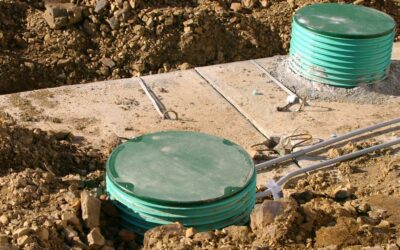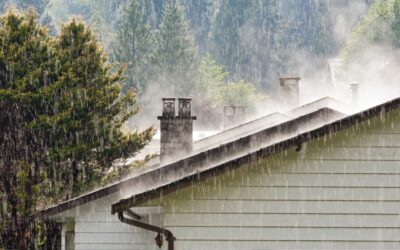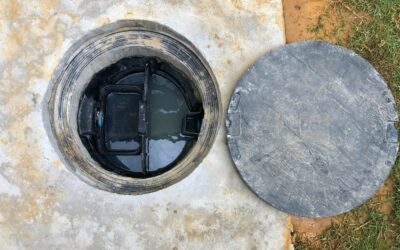Understanding the Importance of Proper Septic Tank Placement
Are you wondering, “How far can a septic tank be from the house?” If so, you’ve landed in the right place. Understanding the proper placement of your septic tank is vital for homeowners looking to preserve the health and effectiveness of their household wastewater treatment. Placement isn’t only a matter of convenience; it’s a legal requirement, with strict regulations and codes to adhere to. Failure to meet these regulations can result in sanitation hazards, environmental damage, and even hefty fines.
If you are looking into building a new house in Massachusetts. Your septic system plays an integral role in your home, silently working behind the scene to keep things running smoothly. If not positioned correctly, a septic tank can cause real chaos – think unpleasant odors, slow drainage, or even sewage backflow!
The entire fuss about placement isn’t arbitrary, rather it’s about safeguarding the functionality of your system, protecting your property, and more importantly, ensuring the well-being of you and your family.
Within the Massachusetts septic tank regulations, disposal facilities must be below water lines, using specific pipes if crossing them; a 50-foot buffer’s needed downhill from vernal pools, with setbacks for high groundwater drains and slopes, and permission’s required for system parts beyond property lines, except for certain fill materials.
Brief Overview of Blackstone Septic Service
At Blackstone Septic Service, we pride ourselves on our complete “customer-first” approach to septic services. From septic cleaning, and grease trap cleaning, to seamless excavation services, our highly experienced technicians are committed to providing you the comfort and peace of mind you deserve. No matter how complicated your septic needs are, we are here ready to provide fast, reliable, and honest service.
Let’s look deeper into the question, ‘how far can a septic tank be from the house,’ and understand the various factors at play. Alongside, we’ll provide you with an ultimate checklist you can refer to when considering a septic tank replacement for your existing septic tank.
Normal Minimum Distance for Septic Tanks in Massachusetts
Minimum 10 feet from your house to prevent any potential structural issues from affecting your house.
At least 15 feet from embankments/drainage ditches to help with the prevention of seepage or contamination of nearby water bodies.
Minimum 50 feet from any water sources to safeguard water quality and further prevent potential contamination from occurring.
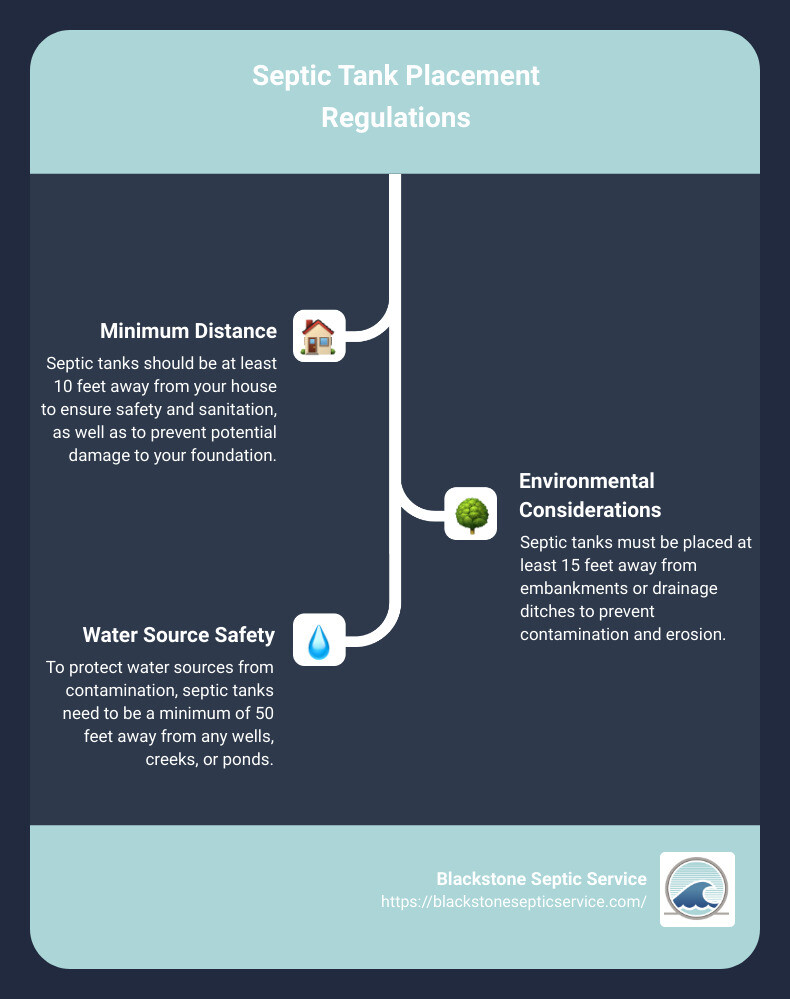
Stay tuned as we dive into septic tank placements, unravel regulations, and pinpoint the multiple influences on your septic tank’s location.
Table of Contents
Understanding Septic Tank Regulations
As we delve into the topic of ‘how far can a septic tank be from the house’, understand that septic tank placement is not a matter of personal preference. Instead, it’s governed by various regulations to ensure public health and environmental safety.
Let’s take a look at some general and specific rules that apply within the Massachusetts area to help with determining your septic tank location.
General Distance Regulations for Septic Tanks
When it comes to septic tank installations, several distance regulations must be strictly adhered to. These regulations vary from state to state and depend on local building codes, but there are some general rules that universally apply.
The septic tank should be at least 10 feet away from water supply lines or property lines and 10 feet from any building’s foundation. The tank should also be at least 15 feet from an embankment or drainage ditch. When it comes to water sources like springs, wells, or sinkholes, the tank must be at least 50 feet away and ideally situated on a downgrade to avoid contamination.
These distances are crucial to ensure that the septic system operates efficiently and safely without posing a risk to the surrounding environment or the health of the homeowners.
Specific Septic Tank Laws in Massachusetts
In Massachusetts, septic tank regulations fall under Title 5, the state environmental code administered by the Massachusetts Department of Environmental Protection (MassDEP). These laws dictate standards for septic system installation, operation, and maintenance, requiring periodic inspections during property transfers and potentially every 2-3 years for routine checks. If a system fails inspection, repairs or upgrades may be mandated to comply with state regulations, prioritizing public health and environmental protection.
These regulations mandate specific setbacks, including maintaining a minimum distance of 100 feet between septic systems and drinking water wells, along with buffer zones from water bodies like rivers, lakes, or streams.
Additionally, local municipalities might have their own regulations supplementing state laws, and professionals involved in septic system work must often hold specific licenses or certifications governed by MassDEP. Staying informed about both state and local regulations is crucial for property owners, contractors, and system professionals to ensure adherence to Massachusetts’ septic tank location laws.
Importance of Local Building Codes in Septic Tank Placement
While we’ve discussed general and state-specific regulations, it’s important to note that local building codes also play a significant role in determining septic tank placement. These codes can vary greatly from one municipality to another, and they often have additional requirements based on the unique geographical and environmental characteristics of the area.
So, whether you’re installing a new tank or maintaining an existing one, we at Blackstone Septic Service always ensure to abide by these regulations and encourage our clients to understand them as well.
At Blackstone Septic Service, we pride ourselves on our in-depth knowledge of local building codes and our commitment to providing services that meet the highest industry standards. Whether it’s a routine septic cleaning or a complex installation, you can trust us to follow all regulations and deliver exceptional results. Reach out to us today for all your septic system needs.
Factors Influencing Septic Tank Placement
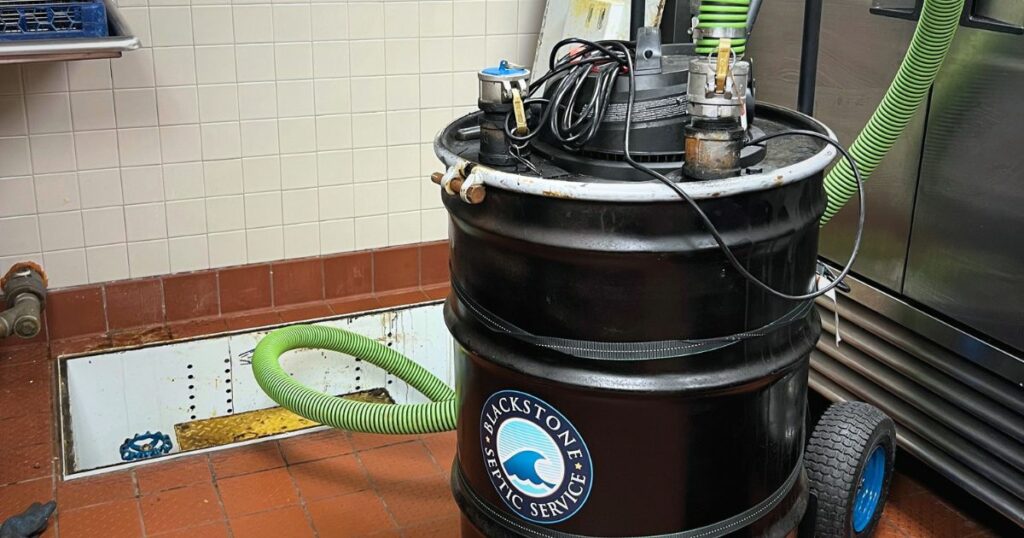
When planning a septic system installation, several factors come into play. Let’s delve into some of the main considerations.
Proximity to the House: How Close Can a Septic Tank Be?
The first question homeowners often ask is, “How far can a septic tank be from the house?” While the answer can vary based on local regulations, a safe rule of thumb is maintaining a typical minimum distance between 10 and 20 feet from the home. This is to prevent contamination or odors from impacting the living space.
In Massachusetts, Title 5 regulations do not specify maximum distance requirements for septic systems in terms of how far a septic tank or leach field can be placed from a building or water source. However, these regulations do mandate minimum distances to ensure proper functionality, maintenance, and environmental protection.
However, it’s crucial to consult with a professional septic service to ensure compliance with local codes.
Proximity to Water Sources: Wells, Creeks, and Ponds
Another critical factor to consider is the septic tank’s proximity to water sources. For example, a septic tank in Massachusetts will need to be at least 50 feet away from a private well.
Surface or subsurface drains intercepting seasonal high groundwater must adhere to specified setbacks, including a minimum 15-foot horizontal separation from the top of the stone or geotextile cover above the pipe to any downhill slope not steeper than 3:1, while areas with steeper slopes require slope stabilization measures, potentially involving a retaining wall designed by a Massachusetts Registered Professional Engineer.
Moreover, it’s worth noting that your septic tank can pump to distances under 750 feet, making it possible to position your septic system further away from water sources if needed.
Proximity to Property Lines and Other Structures
The placement of your septic system should also take into account property lines and other structures. It’s essential to ensure ample space between your septic system and your property line or any neighboring structures. This not only prevents any potential issues with neighbors or local authorities but also helps to ensure the efficient operation of your septic system.
Soil Conditions and Septic Tank Placement
Last but not least, the soil conditions on your property can significantly influence septic tank placement. The ground needs to be suitable for the tank and the leach field, where wastewater is naturally treated and returned to the ground. Soil that is too hard, rocky, or impervious can cause issues with septic system operation and may require additional work or alternative solutions.
When planning for septic tank placement, always remember that each property is unique, and what works for one may not work for another. That’s why it’s crucial to work with a trusted septic service provider like us at Blackstone Septic Service. We have decades of experience and the expertise to help you make the best decisions for your septic system installation.
In our next section, we’ll delve into the technical aspects of septic tank installation, so be sure to keep reading!
Septic Tank Installation Considerations
When installing a septic tank, there are several critical factors to consider. These include the depth of installation, the use of ejector pumps in uphill installations, and preparations for power outages and plumbing emergencies.
Depth of Septic Tank Installation
Typically, septic tanks are installed below ground level, ideally within 10-25 feet from the house. This placement ensures that gravity can effectively transfer waste from the home to the tank. However, the exact depth can vary based on local regulations and the specific characteristics of your property. It’s essential to keep in mind that the guiding principle here is, as John Aldrich, a septic system consultant puts it, “**SEWAGE RUNS DOWNHILL.**”
Use of Ejector Pumps in Uphill Installations
In some situations, such as when the only viable installation location is uphill from your home, an ejector pump becomes necessary. These pumps, powered by electricity, direct the waste upward through the sewer lines and into the septic tank.
However, the use of an ejector pump comes with its own considerations. For instance, in the event of a power outage, the pump would stop functioning. While the pump can typically hold up to 500 gallons for approximately 1-2 days, careful water usage during an outage is crucial to avoid exceeding the pump’s capacity. Additionally, if the pump or septic system fails or gets flooded, the sewage may run back downhill, leading to a major plumbing emergency.
Preparing for Power Outages and Plumbing Emergencies
Given the potential issues with ejector pumps and septic systems, it’s crucial to have a plan in case of power outages and plumbing emergencies. Limiting water usage during power outages can prevent overloading the pump or system. Regular maintenance and inspection, like those provided by us at Blackstone Septic Service, can help identify potential problems early and prevent major emergencies.
In conclusion, determining how far a septic tank can be from the house involves careful consideration of various factors and potential issues. At Blackstone Septic Service, we bring our extensive experience and expertise to ensure your septic tank installation is done right, providing you with a reliable and efficient system.
Septic Tank Maintenance and Inspection
Beyond understanding the importance of septic tank placement, another crucial aspect is routine maintenance and inspection of your septic system.
Massachusetts property owners must understand their duty in maintaining and testing septic systems properly; failure to comply could lead to fines, environmental dangers, and potential health hazards.
Regular Septic Cleaning and Its Importance
Regular cleaning of your septic system is a critical practice to maintain its functionality and longevity. Not only does this routine task prevent the buildup of solid waste, but it also keeps the system running smoothly.
It’s recommended to pump your septic tank every 2-3 years, as this will help maintain the longevity of your system. Ignoring this practice could lead to septic failure, displaying symptoms such as wet or soggy areas above the leach field, slow draining pipes, and even waste odors permeating your home.
Role of Professional Services in Septic Tank Maintenance
While some aspects of septic maintenance can be done by homeowners—like ensuring waste materials that can clog the pipes aren’t flushed—it’s highly advisable to rely on professional services for the more technical tasks. These include the actual cleaning of the tank, inspection for potential issues, and addressing necessary repairs.
A professional service team has the experience and tools to perform these tasks efficiently and safely, reducing the risk of problems arising in the future. Moreover, professionals are knowledgeable about the local regulations and can ensure that your septic system is compliant, further saving you from potential troubles.
Using a plumbing snake to clear sewer clogs is a common and effective method in Massachusetts. A plumbing snake, also known as an auger, is a flexible tool that breaks up and removes blockages within sewer lines. When dealing with a sewer clog, feeding the snake into the affected pipe can help dislodge debris, tree roots, or other obstructions causing the blockage. Using a metal plumbing snake for the specific sewer line and clog is important. While snaking can be done by homeowners, severe clogs or persistent issues might require professional assistance.
Blackstone Septic Service: Your Partner in Septic Tank Maintenance
At Blackstone Septic Service, we take pride in providing top-quality septic tank services to our clients in central Massachusetts. Our team is fully licensed and insured, bringing over 75 years of experience to the table.
We understand the importance of a well-maintained septic system and are committed to helping our clients achieve this. Our services include regular septic cleaning, inspection, and necessary repair works. We also offer emergency services, because we know that septic issues can happen at any time.
A well-maintained septic system not only serves its function efficiently but also contributes to the overall health of your environment. If you need septic services, don’t hesitate to reach out to us. We’re here to help!
Recap of Key Points on Septic Tank Placement in Massachusetts
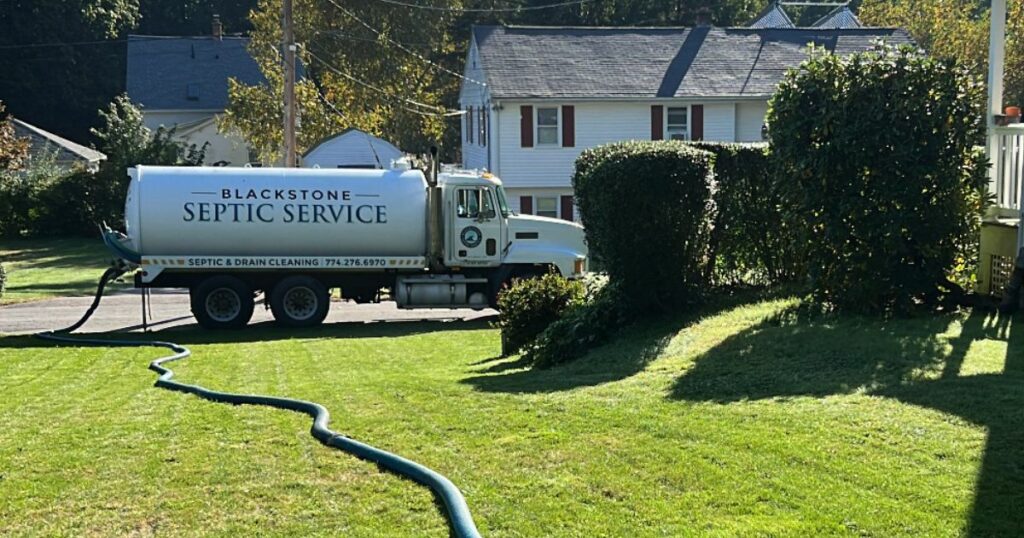
To ensure your septic system operates effectively and efficiently, it’s vital to understand the regulations and factors that influence its placement. We’ve discussed how distance regulations vary, but consider the proximity of your septic tank to your home, other structures, property lines, and water sources.
In Massachusetts, septic system placement rules aim to protect your property and family by ensuring system efficiency and minimizing contamination risks. The rules say that disposal facilities should sit at least 18 inches below water supply lines, and if sewer lines cross those, they’ve gotta be made of a certain kind of strong sewer pipe and tested to make sure they don’t leak.
There’s a 50-foot buffer needed if you can prove with good data that your drainage system is downhill from the vernal pool, and drains catching high groundwater need some space too, plus a 15-foot gap from slopes not too steep. It is important to note that slopes are often necessary for sewer line installation.
The soil condition also plays a crucial role in deciding the septic tank’s placement. It’s necessary to conduct soil tests to ascertain its capacity to absorb effluent. Also, the septic tank should be installed at a depth that ensures it doesn’t settle over time and is covered by at least 6 inches of soil.
Final Thoughts on How Far Can a Septic Tank Be From the House
Understanding how far a septic tank can be from the house is just one part of the equation. Regular maintenance, including periodic cleaning every 2-3 years, is equally important to extend the lifespan of your septic system. It helps prevent major issues like backups, leaks, and unpleasant waste odors.
At Blackstone Septic Service, we are committed to providing the best septic services in Central MA. Not only will we help you understand the regulations for septic tank placement, but we’ll also ensure your system is installed correctly and maintained by a plumbing line cleaning tool. We believe in educating our clients about their septic systems, helping them avoid potential problems, and ensuring they enjoy a healthy, hassle-free living environment.
If you need more information on septic tank regulations or require professional septic services, don’t hesitate to contact us. For more insights and expert advice on septic system maintenance, check out our resources page, it is important to note that requirements vary.
Our Content
Our experienced septic tank specialists have carefully reviewed and edited all of the content to ensure that it meets our high standards for quality and accuracy. At Blackstone Septic Service, our mission is to provide unparalleled expertise and service excellence in the realm of septic system care. With a dedicated team of professionals committed to delivering top-tier solutions, we specialize in comprehensive services encompassing everything from existing system routine maintenance like septic tank pumping and cleaning to intricate repairs, thorough inspections, and new septic tank system installations.
Customer satisfaction is at the core of our operations, and we pride ourselves on our prompt, reliable, and customer-centric approach. Blackstone Septic Service is a family owned company with highly trained technicians, with over 75 years of experience in septic tanks.

